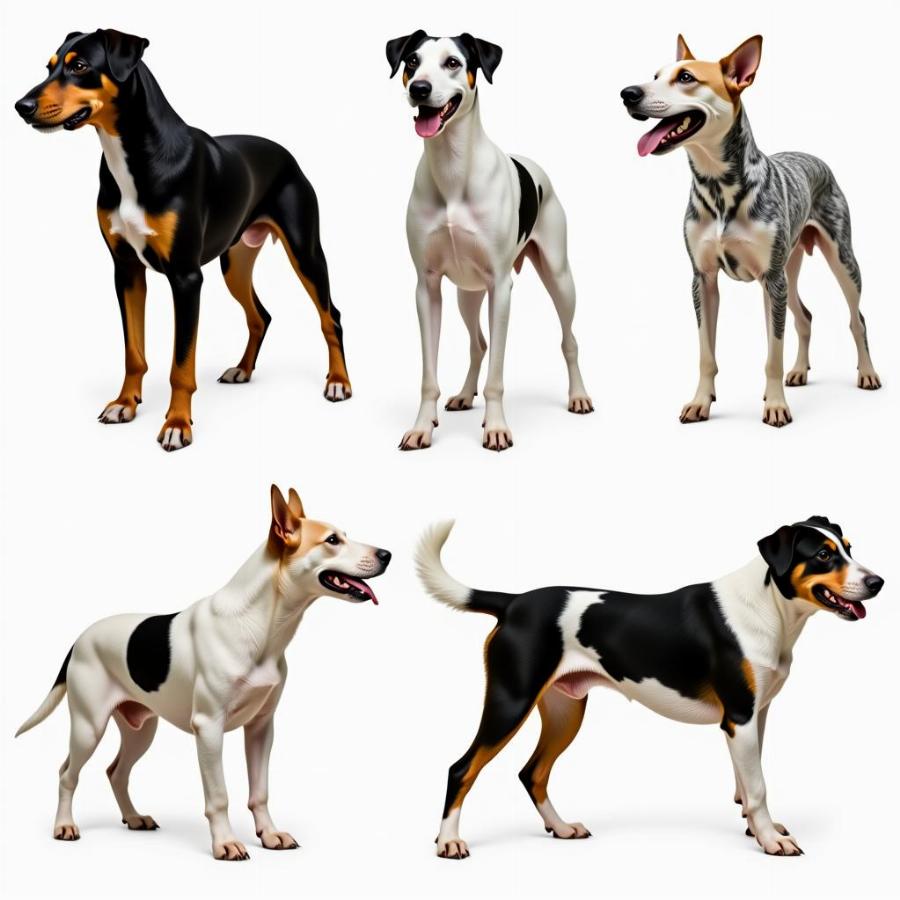Dog coat patterns are a fascinating aspect of canine genetics. Understanding these patterns not only helps you identify breeds but also appreciate the incredible diversity within the canine world. From the classic spots of a Dalmatian to the brindle stripes of a Boxer, “patterns for dog coats” offer a glimpse into the complex world of canine genetics and can help you choose the perfect furry friend for your lifestyle.
Understanding Basic Dog Coat Patterns
Before diving into the specifics of each pattern, let’s cover the basics. Dog coat patterns are primarily determined by genes that control pigment production and distribution. These genes interact in various ways, resulting in a wide array of colors and markings. Knowing the basics will help you decipher the sometimes complex descriptions of different breeds’ coat patterns.
Solid Colors
Even seemingly simple solid colors are governed by genetics. A dog with a truly solid coat has a single pigment color expressed throughout its fur. Common examples include black, chocolate brown, red, and white.
Bicolor Patterns
Bicolor patterns involve two colors, often white combined with another color like black, brown, or tan. These patterns can vary significantly, from the classic black and white of a Border Collie to the tuxedo markings of a Boston Terrier.
 Ví dụ về các kiểu lông chó hai màu
Ví dụ về các kiểu lông chó hai màu
Tricolor Patterns
Tricolor patterns, as the name suggests, feature three distinct colors. The most common combination is black, white, and tan, often seen in breeds like Beagles and Bernese Mountain Dogs.
Merle Patterns
Merle is a striking pattern characterized by irregular patches of diluted pigment on a solid or bicolor background. The merle gene can affect various colors, resulting in blue merle, red merle, and other variations. However, it’s important to be aware of potential health concerns associated with breeding two merle dogs together.
More Complex Dog Coat Patterns
Beyond these basic patterns, there’s a whole world of intricate and fascinating coat variations. These more complex patterns add to the unique beauty and individuality of each dog.
Brindle Patterns
Brindle is characterized by tiger-like stripes that appear over a base coat color. The stripes can vary in color and intensity, creating a striking visual effect. Boxers, French Bulldogs, and Greyhounds are just a few examples of breeds that commonly exhibit brindle patterns.
Sable Patterns
Sable coats have a darker tipping on the ends of the hairs, creating a shaded effect. The base coat color can vary, and the darker tipping can be more pronounced in certain areas, such as the back and tail.
Ticked Patterns
Ticking refers to small, isolated areas of color, often on a white background. This pattern is often seen on the legs and muzzle of dogs like the English Setter and Dalmatian.
How Coat Patterns Help Identify Breeds
While coat patterns aren’t the sole determinant of breed, they play a significant role in identification. Certain patterns are strongly associated with specific breeds, providing valuable clues for determining a dog’s lineage. For example, the distinctive spots of a Dalmatian are a hallmark of the breed.
FAQ: Common Questions About Dog Coat Patterns
Q: Do coat patterns change as a dog ages?
A: While some minor changes can occur, a dog’s basic coat pattern is generally established at birth.
Q: Are certain coat patterns linked to specific personality traits?
A: No, there’s no scientific evidence linking coat patterns to personality.
Q: Can I predict a puppy’s coat pattern based on the parents’ patterns?
A: Yes, to some extent. Understanding basic canine genetics can help predict possible coat patterns in offspring.
Q: Are some coat patterns more prone to certain health issues?
A: Yes, certain patterns, like merle, are associated with specific health concerns.
Q: What’s the rarest dog coat pattern?
A: It’s difficult to definitively say, but some of the rarer patterns include brindlequin and merlequin.
Conclusion
Dog coat patterns are a captivating testament to the diversity within the canine world. Understanding these patterns allows us to appreciate the complex genetics at play and helps us identify and admire the unique beauty of each individual dog. Whether you’re fascinated by the classic spots of a Dalmatian or the intricate stripes of a brindle coat, exploring “patterns for dog coats” provides a deeper understanding and appreciation for our canine companions.
Do you have more questions about dog coat patterns? Check out our other articles on roan color dog and lion’s mane costume for dogs for more information.
Beaut Dogs is your trusted source for all things dog-related. We provide reliable and expert information on various dog breeds, their care, and much more. For any assistance or detailed information, please contact us via Email at [email protected]. Beaut Dogs is here to help you navigate the wonderful world of dog ownership.